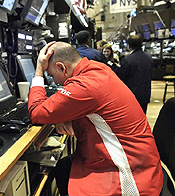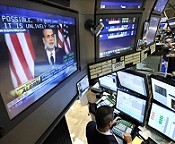VOA标准英语10月-World Stock Markets Again Fall Sharply as Federal(在线收听)
 |
| Wall Street traders, 07 Oct 2008 |
The Dow Jones Industrials lost 508 points to 9,447. The technology heavy Nasdaq market lost over four percent to close at a five-year low. Analysts say the markets continuing decline is evidence of market skepticism that the Bush administration's $700-billion financial rescue measure will have the desired effect.
Federal Reserve Board Chairman Ben Bernanke spoke to a conference (in Washington) and for the first time suggested that the central bank may consider a further interest rate cut to boost economic growth.
"In light of these [recent] developments the Federal Reserve will have to consider whether the current stance on policy is appropriate," said Bernanke.
 |
| Fed Chairman Ben Bernanke, seen on a television screen on the New York Stock Exchange trading floor, during his luncheon address to the National Association for Business Economics, 7 Oct. 2008 |
Some analysts expect coordinated action by central banks in Europe, America and Japan to cut rates to deal with the global credit squeeze. Central bank chiefs and finance ministers from the seven biggest financial powers gather in Washington on Friday for a previously scheduled meeting. In his address to the Washington conference, Bernanke said economic growth is slowing as a result of credit crisis.
"Overall, the combination of incoming data and recent financial developments suggest that the outlook for economic growth has worsened and that the downside risks to growth have increased," he said.
The US and several European stock markets have declined for five consecutive trading sessions. Overnight lending between banks remains largely frozen and bank shares were big losers Tuesday in both Europe and North America.
Oil gained $2 and gold was up $16. The dollar remained strong but closed off its session highs.
Australia late Tuesday cut its short-term interest rate by a full percentage point, a move likely to be followed by other Asian economies.